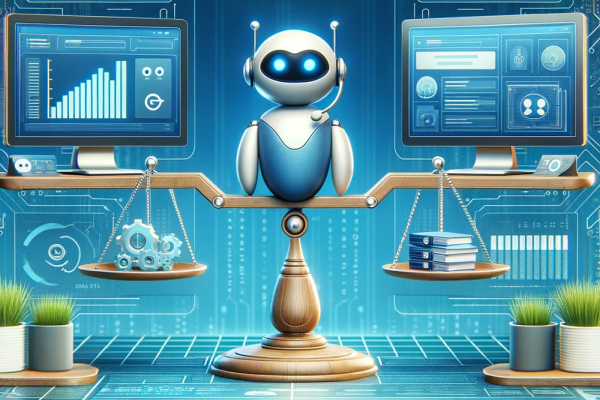AI is transforming customer support in 2025 by making interactions faster, cheaper, and more effective. Here’s what you need to know:
- Faster Service: AI tools cut response times by 37% and resolve tickets 52% faster.
- Cost Savings: Businesses see a 35% reduction in operational costs.
- Improved Satisfaction: 77% of teams report better customer satisfaction scores.
- Automation: Up to 80% of routine tasks are handled by AI, freeing up human agents for complex issues.
Key tools include advanced chatbots, emotion analysis systems, and predictive problem prevention. These systems blend automation with human expertise, ensuring 24/7 support while maintaining a personal touch. Businesses adopting AI see measurable benefits like higher productivity, increased revenue, and better ROI.
Quick Stats:
| Metric | Improvement |
|---|---|
| First Response Time | 37% faster |
| Ticket Resolution Speed | 52% faster |
| Cost Reduction | 35% lower |
| Customer Satisfaction | 77% teams report gains |
AI is reshaping customer support by combining speed, efficiency, and personalization, helping businesses stay competitive while meeting growing customer expectations.
Key AI Tools in Modern Customer Support
AI tools have revolutionized customer support, making it faster and more tailored to individual needs. Providers like Resolve247.ai are leading the charge, offering tools that enable real-time, context-aware interactions, forming a critical part of advanced support systems.
Advanced AI Chatbots
Today’s AI chatbots can handle both simple and complex queries with ease. For instance, Resolve247.ai’s AIChatbot is available 24/7, delivering instant and accurate responses while minimizing errors to maintain customer confidence. These chatbots not only understand customer concerns but also escalate more complicated issues to human agents when necessary. They pull in information from multiple sources, ensuring replies align with the company’s voice and branding.
Customer Emotion Analysis Tools
Customer support is no longer just about answering questions – it’s about understanding emotions. Tools like Resolve247.ai’s ResponseAssistant help teams craft replies that match the emotional tone of the interaction while staying true to the company’s style. By analyzing past interactions and internal data, these tools enable faster, more empathetic responses, easing the burden on support teams and speeding up reply times.
Predictive Problem Prevention
AI isn’t just reactive – it can also prevent problems before they arise. Predictive systems analyze data to identify potential issues, keeping operations smooth and consistent. Resolve247.ai’s auto knowledge top-up feature is a great example, continuously updating the support database to ensure thorough coverage. This is especially useful for large-scale operations managing up to 50,000 customer queries monthly. By addressing potential problems early, this tool simplifies workflows and keeps teams focused.
These AI solutions create a well-rounded support system that blends automation with human expertise, improving efficiency and maintaining top-notch customer interactions.
AI Tools for Support Teams
Today’s customer support teams rely on AI tools to meet increasing customer demands while ensuring top-notch service. These tools boost agent efficiency and help maintain consistent service quality.
Auto-Generated Response Systems
AI isn’t just for customer-facing tasks; it’s also a game-changer for internal workflows. For example, Resolve247.ai’s ResponseAssistant drafts replies directly in agents’ inboxes. By analyzing past responses, website content, and help documentation, it creates accurate, on-brand replies [3].
Here’s what makes auto-generated responses so effective:
- Cut down on manual drafting for repetitive questions
- Ensure consistent messaging across all communications
- Speed up response times significantly
- Handle more inquiries without needing to hire additional staff
However, automation works best when paired with human expertise to address more nuanced customer needs.
Balancing AI and Human Support
Striking the right balance between AI tools and human support is essential. While AI can handle routine tasks and draft responses, human agents are vital for tackling complex issues that require empathy, creativity, and judgment.
To integrate AI successfully, support teams should:
- Start small: Use tools like ResponseAssistant for drafting before diving into full chatbot solutions
- Ensure compatibility: Choose AI systems that work seamlessly with your existing workflows and ticketing platforms
- Train thoroughly: Help agents understand how to collaborate effectively with AI tools
- Continuously evaluate: Monitor AI and human interactions to fine-tune the balance and improve customer satisfaction
"Our tools make every interaction smarter, faster, and more efficient; so you can keep customers happy, keep your team happy AND push your business forward." – Sam Cox, Founder of Resolve247.ai [3]
sbb-itb-bd61b1a
Measuring AI Support Performance
AI support systems need precise tracking of both performance and financial outcomes to ensure investments are worthwhile.
Key Metrics for AI Support
It’s crucial for organizations to monitor indicators related to customer satisfaction and operational efficiency. Customer-focused metrics include CSAT (Customer Satisfaction Score), NPS (Net Promoter Score), CES (Customer Effort Score), and First Contact Resolution. On the operational side, metrics such as Average Handle Time, First Response Time, Automated Resolution Rate, and Bot Engagement Rate are essential [4].
For example, a telecommunications company that implemented real-time agent assistance saw a 20% boost in productivity and a 15% increase in first-contact resolution, which directly improved its financial performance [4]. These measurable outcomes clearly highlight the value AI can bring.
Financial Impact of AI Support
When AI-driven efficiencies are achieved, they lead to both direct cost savings and indirect financial benefits [6].
A Forrester Consulting study on Webex Contact Center showed impressive results: $3.6 million saved through 20% call deflection, $1.7 million reduced IT costs, and $3.5 million saved by eliminating legacy software expenses. This led to a 304% ROI with payback in under six months [7].
To effectively measure ROI, organizations should:
- Set baseline metrics before deploying AI.
- Track immediate and long-term savings.
- Evaluate the combined impact of all AI initiatives.
- Account for maintenance and training costs.
Take PayPal as an example – AI advancements helped the company nearly double its payment volumes from $712 billion to $1.36 trillion, while cutting loss rates by about 50% [6].
In another case, a major bank used an AI-powered video solution to handle 10,000 calls monthly, achieving 83.64% customer satisfaction and improving its NPS by 18% through proactive interventions [4].
IBM research highlights that top-performing companies see an average 13% ROI on AI projects, more than double the average ROI of 5.9% [5]. This shows that strategic use of AI not only enhances service quality but also significantly boosts profitability.
Common AI Implementation Issues
Understanding and addressing implementation challenges is key to making the most of AI. While AI can enhance customer support, it also comes with hurdles that need careful attention.
Data Security Requirements
Protecting data is critical as AI systems handle large volumes of sensitive information. In the first half of 2022 alone, 817 data breaches were reported in the US [8].
To safeguard data, make sure to pick a solution that uses the following:
- Use end-to-end encryption for both data in transit and at rest.
- Implement multi-factor authentication to secure system access.
- Conduct regular security audits and penetration testing.
- Ensure compliance with regulations like GDPR and CCPA.
Here’s a breakdown of key security measures:
| Security Aspect | Implementation Requirements | Benefits |
|---|---|---|
| Data Collection | Limit data collection to necessary info with clear consent | Builds trust and ensures legal compliance |
| Access Control | Use role-based permissions and monitoring systems | Prevents unauthorized access |
| Storage Security | Encrypt cloud storage and maintain regular backups | Protects against breaches and data loss |
| Compliance | Perform audits and update processes to meet regulations | Avoids fines and legal issues |
Connecting AI with Current Systems
Integrating AI with existing tools can sometimes be challenging. Look out for providers that have integrations to work alongside your existing tools, and that are designed for quick onboarding (i.e no custom coding requirements).
Key steps for integration:
- System Assessment: Review current tools and identify where AI can add value. Consider that built-in tools may not be the highest quality, consider that AI specialists have AI as their focus and so generally provide a better quality AI.
- Avoid Data Migration: Check if the tool requires laborious data migration, or if it will simply work with your existing data in its current form.
- Thorough Integration: a good AI tool should assist in workflow, not provide any extra steps – look for AI tools that are integrated in a way that will help your workflow, for example not requiring any additional copy/paste. The integration should be seamless, to give AI the best chance of assisting your workflow.
"Resovle247 seamlessly integrates with the tools we already use, the transition to AI-powered customer service was quick! Without disrupting our workflow."
Staff Training for AI Tools
Proper training can significantly improve outcomes. Statistics show:
- 56% faster agent proficiency.
- 33% higher customer satisfaction (CSAT) scores.
- 32% reduction in employee turnover [10].
"By using generative AI to train unique scenarios that could occur in real situations, reps will be more adept at handling whatever customer issue comes their way." – IBM [11]
Sony’s approach underscores the value of training. Their AI chatbot manages over 30,000 inquiries monthly, maintaining an impressive 80% resolution rate. These results highlight how effective training can boost both customer satisfaction and operational efficiency.
What’s Next for AI Support
AI-powered customer support is transforming the way businesses interact with their customers, offering smarter, faster, and more tailored solutions.
Emerging AI Support Features
According to Gartner, conversational AI could slash contact center labor costs by $80 billion by 2026 [12].
"AI isn’t replacing human agents; it’s enhancing their capabilities and making customer service more intelligent, efficient, and personalized than ever before. Businesses that invest in AI now are shaping the future of customer experience for years to come." – Jay Phoenix [13]
Adapting to Future Customer Needs
As AI technology continues to evolve, it not only drives down costs but also enhances the quality of customer interactions. Here’s how businesses are leveraging AI today:
- 76% of CX leaders are already using or testing AI for personalized experiences [15].
- 72% use AI to pinpoint pain points in the customer journey [15].
- 20% have adopted AI tools designed to simulate empathy [15].
Companies like Netflix and Tesla are leading the way. Netflix uses predictive analytics to identify users who might cancel their subscriptions, offering personalized recommendations to keep them engaged [14]. Tesla employs predictive maintenance to alert customers about potential vehicle issues before they arise [14].
Looking ahead, the future of AI support is centered around three major areas:
1. Proactive Problem Resolution
Businesses like T-Mobile use predictive analytics to identify customers ready for plan upgrades, boosting revenue per user [14].
2. Enhanced Personalization
Starbucks tracks customer purchasing habits through its loyalty program, offering customized rewards that drive engagement [14].
3. Emotional Intelligence
AI tools capable of simulating empathy are improving customer interactions, with 20% of CX leaders already utilizing these solutions [15].
With 96% of businesses anticipating generative AI to further elevate customer experiences [1], the next wave of AI advancements promises smarter, more cost-effective, and highly personalized support solutions.
Conclusion
AI has become a key player in customer support as we look toward 2025. It offers businesses faster response times, reduced costs, and improved customer satisfaction through instant replies and smoother workflows.
Getting started with AI doesn’t have to be complicated. Tools like Resolve247.ai’s ResponseAssistant, which drafts replies directly in existing inboxes, and their AI Chatbot for 24/7 support, show how AI can easily fit into current systems and elevate customer service operations.
The benefits of AI in customer support are undeniable. By speeding up responses and lightening workloads, AI allows support teams to tackle more complex, human-focused issues. Let’s take a closer look at some key priorities and their measurable outcomes:
| Implementation Focus | Key Benefit | Success Metric |
|---|---|---|
| Response Automation | Faster reply times | 24/7 availability |
| Knowledge Base Integration | More accurate answers | Reduced ticket volume |
| Human Oversight | Quality assurance | Higher satisfaction rates |
| Workflow Integration | Easy adoption | Improved efficiency |
These metrics highlight how AI can reshape operations for the better. The challenge lies in blending AI’s speed and precision with the human touch. Businesses can start small with basic AI tools and expand based on performance, creating a support system that keeps up with modern customer demands while staying competitive.



